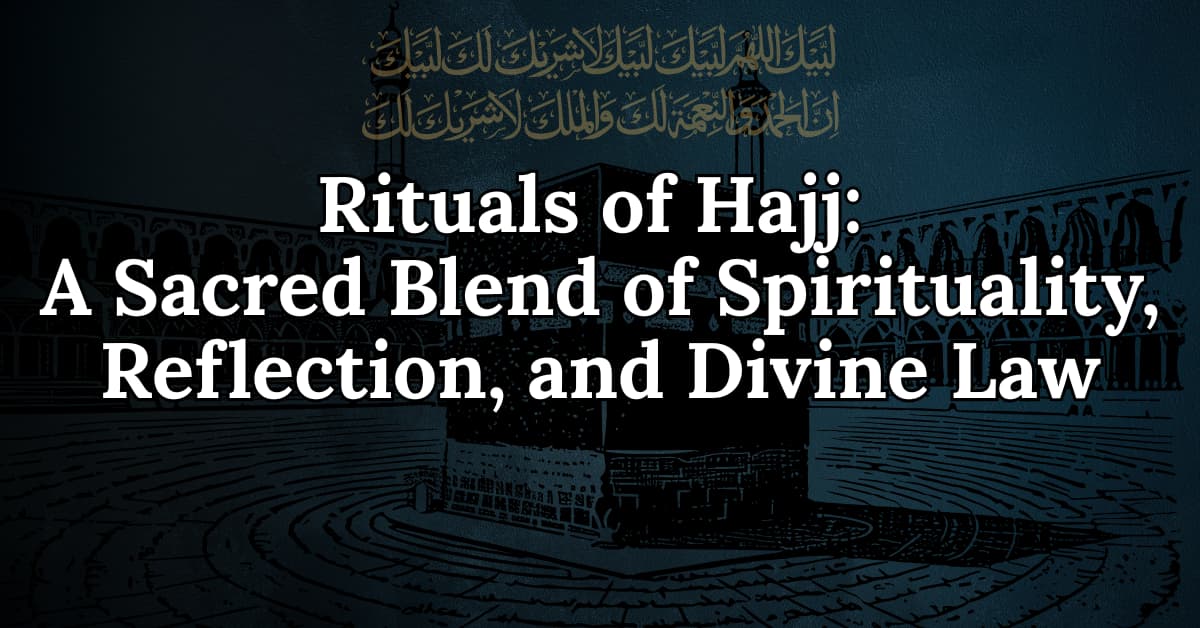Hajj is not merely a physical pilgrimage; it is a transformative spiritual journey, one of the most profound experiences in a Muslim’s life. The rituals of Hajj are not limited to external acts of worship; they serve as instruments for inner purification, ethical refinement, and a deeper connection with the Creator. This article explores the spiritual, psychological, philosophical, and legal dimensions of Hajj, examining how each ritual leaves a lasting imprint on the soul and draws the believer closer to Allah.
The Journey to Mina: Entering a Covenant
As the pilgrim, draped in the simplicity of Ihram, enters the valley of Mina echoing “Labbayk Allahumma Labbayk” (“Here I am, O Allah, here I am”), they are not just a traveler, they are a living testament to a covenant with the Divine. This moment marks a symbolic refusal of all falsehoods and worldly delusions, affirming loyalty to truth and submission to God alone.
Stoning the Jamarat: A Declaration of Inner Jihad
The act of throwing pebbles at the pillars representing Satan (Jamarat) may appear simple, but it touches the highest peak of servitude. It is a symbolic declaration of war against the ego, temptation, and worldly desires, reminiscent of the courage and submission of Prophet Ibrahim (AS).
It was during his test that Satan tried to divert him, yet he rejected the whisperings each time by pelting stones. The pilgrim, too, stands in this symbolic battlefield, affirming their resistance to all distractions that pull them away from Divine guidance.
Tawaf: Circling the Divine Center
Tawaf (the act of circling the Kaaba seven times) is one of the most iconic and spiritually charged rituals of Hajj and Umrah. The Quran refers to the Kaaba as “a place of return for the people and a sanctuary” (Surah Baqarah 2:125). This central act of worship draws millions in unison toward a singular spiritual axis.
Imam Al-Ghazali’s Reflection on Tawaf
Imam Abu Hamid Al-Ghazali (d. 505 AH) explains:
“Tawaf is like Salah. During it, the heart must be filled with the same humility, fear, hope, and love required in prayer. True Tawaf is the circling of the heart around Allah. It mirrors the angels’ Tawaf around the Throne of Allah. When your life begins and ends with the remembrance of Allah, that is the real Tawaf.”
(Ihya Ulum al-Din, Beirut: Dar Ibn Hazm, 2005, p. 318)
Changing the Qiblah: True Righteousness Beyond Direction
The Kaaba’s sanctity does not lie in its walls or cloth but in the Divine command. During the Prophet’s early mission, Muslims prayed facing Jerusalem. Later, the Qiblah was divinely changed to the Kaaba. The Quran emphasized the essence of righteousness:
“Righteousness is not turning your faces towards the east or the west, but righteousness is in one who believes in Allah, the Last Day, the Angels, the Book, and the Prophets…”
(Surah Al-Baqarah 2:177)
Kissing the Black Stone: A Symbol of Repentance
The act of kissing the Hajar al-Aswad (Black Stone) symbolizes humility and repentance. Caliph Umar ibn Al-Khattab (RA) once said:
“By Allah, I know you are just a stone, you can neither harm nor benefit. If I had not seen the Messenger of Allah (PBUH) kiss you, I would never have kissed you.”
(Sahih Muslim, Hadith 1270)
Some symbolic traditions explain its deeper meaning:
- “The Black Stone is Allah’s right hand on earth; whoever kisses it is as if kissing Allah’s hand.”
(Ibn Adi, Al-Kamil 1/336 – Weak narration) - “The covenant Allah took from humanity was placed inside the Black Stone.”
(Attributed to Aisha, Ibn Qutayba, Ta’wil Mukhtalif al-Hadith, p. 406)
Ultimately, Tawaf reinforces the central idea: Allah must be the center of our lives, just as the Kaaba is the center of the ritual. The beginning and end of every believer’s journey must be with Allah, whether we consciously recognize it or not.
Origins of the Kaaba: A Historical Perspective
While the Qur’an attributes the raising of the Kaaba’s foundations to Prophet Ibrahim (A.S) and Ismail (A.S):
“When Ibrahim and Ismail raised the foundations of the House…”
(Surah Al-Baqarah 2:127)
Some scholars believe the Kaaba existed even earlier. A hadith in Sahih Bukhari states:
“There were forty years between the building of the Kaaba and Bayt al-Maqdis (Jerusalem).”
(Sahih Bukhari, Hadith 3186)
Ibn al-Jawzi (d. 597 AH) and Ibn Hajar al-Asqalani (d. 852 AH) conclude from this that the Kaaba was first built by Prophet Adam (A.S). Ibn Hajar narrates from Qatadah:
“Allah established the Kaaba with Adam so he could remember the angels’ glorification and perform Tawaf just as they do around the Throne.”
(Fath al-Bari, vol. 6, p. 467–471)
The Sai Between Safa and Marwah: A Legacy of Faith and Struggle
The ritual of Sai (walking seven times between the hills of Safa and Marwah) commemorates the courage and trust of Hagar (Hājar), the mother of Ismail (A.S). Abandoned in the barren desert upon Divine command, she asked Ibrahim (AS): “Is this from Allah?” When he affirmed, she replied:
“Then He will not abandon us.”
(Sahih Bukhari, Hadith 3364)
Out of desperation for her thirsty child, she ran between the hills seeking water. Eventually, the angel Jibril (A.S) struck the earth, and the spring of Zamzam gushed forth, laying the foundation for the future city of Makkah.
Sai: A Symbol of Hope and Trust
The Sai teaches that complete reliance on Allah, combined with effort, leads to divine providence. A profound quote from an anonymous Muslim scholar captures this:
“The one floating on a plank in the ocean is no more in need of Allah than you are.”
This experience is even more poignant because it centers on the actions of a woman who was neither wealthy nor noble, but her sincerity and faith were so beloved to Allah that He made her striving a permanent part of worship.
Al-Ghazali’s Insight on Sai and the Day of Judgment
Imam Al-Ghazali compares Sai to the Day of Judgment:
“Running between Safa and Marwah reflects the journey between hope and fear. Life is a race between good and evil, and Sai is a symbolic rehearsal for that ultimate test, where one hopes their good deeds will outweigh the bad.”
(Ihya Ulum al-Din, p. 319)
Arafah: The Pinnacle of Hajj
Arafah (a plain east of Makkah) is the most crucial station of Hajj. On the 9th of Dhul-Hijjah, pilgrims gather here in collective prayer, repentance, and supplication until sunset.
Standing at Arafah: The Heart of Hajj
This gathering represents the culmination of the entire pilgrimage. The Prophet Muhammad (PBUH) said:
“Hajj is Arafah.”
(Abu Dawud, Hadith 1949)
Without standing at Arafah, the Hajj is considered incomplete.
Conclusion: A Journey toward the Divine
Every ritual in Hajj is more than symbolic, it is a living reflection of obedience, humility, trust, and struggle. From stoning the devil to circling the Kaaba, from Hagar’s tireless search to the collective tears on Arafah, each step of Hajj transforms the believer.
It is in these sacred rites that the Muslim finds not just religious obligation, but a roadmap to spiritual awakening, divine proximity, and eternal hope.



